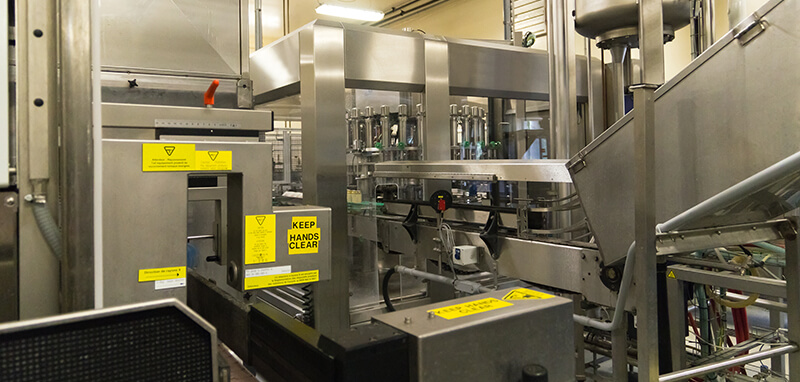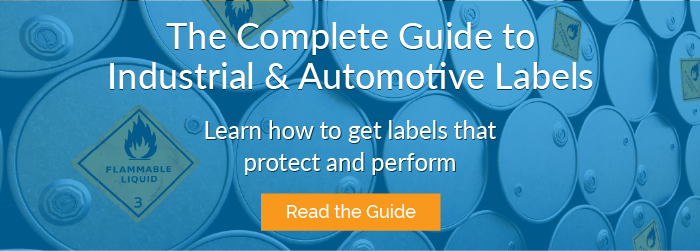
Industrial labels and industrial equipment have at least one thing in common: They both exist to do a job.
Industrial labels aren’t designed to sell a brand like food and beverage labels. They don’t follow design trends, and they certainly don’t need to be clever.
Industrial labels are more like the metal and electronic components of a piece of equipment – elements of a greater whole built for a specific function. And like these components, the quality of an industrial label can impact the effectiveness of the equipment you produce, as well as the workplace efficiency, productivity, and safety of your customers.
Given the critical role labels play in industrial applications, exacting standards should apply to your choice of label printer.
Here are three label-related headaches an experienced industrial label printer can help you avoid:
1. Overengineering or Under-engineering Your Label
Industrial labels typically impart critical information, from hazard warnings (often required by workplace safety regulations) to on-off switch positions. As a manufacturer, you can’t afford to have this information obscured by faulty labels.
Several factors commonly found in industrial environments can cause labels to peel, rip, or fade. Caustic solvents, high heat, rapidly fluctuating temperatures, dust, moisture, and constant motion can all weaken label materials, destabilize adhesives, and discolor ink. Industrial labels must be engineered to withstand these environmental threats so the labels can continue doing their jobs day after day.
Some industrial organizations make the mistake of “under-engineering” their labels. Instead of designing a label for their current application and setting, they default to the same specifications they’ve used for decades, even though those specifications may not be best suited for their current needs. Others make the mistake of “over-engineering” their labels – that is, paying for unnecessary label features.
A qualified industrial label printer will help you choose suitable label material, adhesive, and ink for your present needs, regardless of what you’ve done in the past.
If your label printer asks you a lot of questions about your application, take it as a positive sign. They’re not trying to annoy you. Your printer merely wants to help you make the right choices to maximize the value and life of your industrial label.
2. Struggling to Achieve Compliance
Labels may seem insignificant when contrasted with huge pieces of machinery and vast workspaces, but a label failure can bring you or your customer’s operations to a halt.
Most industrial firms are aware of their obligations to comply with federal and state safety protocols. But what you may be less aware of is that when compliance inspectors visit a worksite, they’re not just looking to make sure the right fonts, colors, and symbols have been chosen for hazard warnings. Compliance agencies also expect regulation-mandated labels to be legible and intact.
When managing risk is a priority, you need to have confidence in your labels. The way to prevent substandard labels from jeopardizing your customer’s productivity and safety, damaging your reputation, and incurring fines, is to partner with a label supplier that takes your compliance requirements as seriously as you do. A one-label-fits-all approach simply won’t cut it.
3. Making Assumptions That Cost Money and Time
Your industrial label printer may be capable of much more than you realize.
For example, you don’t necessarily have to print serial numbers yourself. Your label printer may be able to serialize your labels for you. Similarly, many printers can handle printing different label batches to align with different product models.
If you plan to do any additional printing onto your labels after receiving them, be sure to bring it up with your label printer (ideally, though, they’ll ask about this on their own). Chances are, they’ll have options to help you and will walk you through the possibilities with patience and clarity.
Here’s another example: Do you know the difference between direct thermal printing and thermal transfer? They’re both thermal processes, but they both require different printing surfaces.
An expert in industrial label printing will know to press you for more information as soon as they hear the word “thermal.” Otherwise, you could end up wasting money on a label that’s utterly ill-suited for your needs.
The Right Industrial Label Printer = Problems Solved
Industrial labels do an incredibly important job. Fortunately, it’s not difficult to get labels that are up to the task. With the right industrial label printer on your side, you shouldn’t have to prepare much – or at all – to talk with your printer. Your printer should lead the conversation so that you get the best label possible.
But if you’re the type of person who likes to do their homework, get ready for an informed discussion with your label printer by familiarizing yourself with our free “Complete Guide to Industrial and Automotive Labels.”

